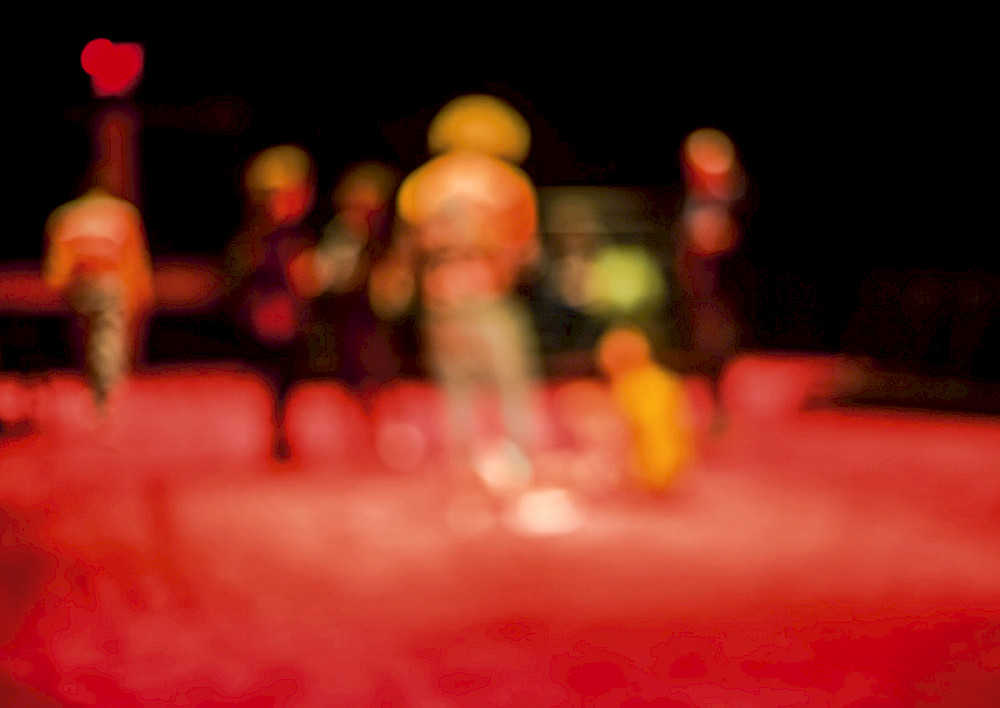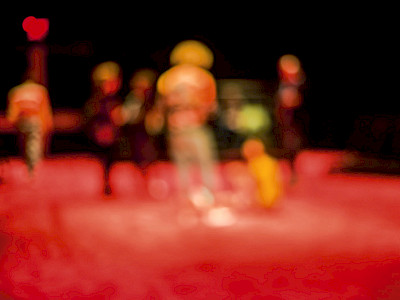24 — 27.05.2017
By radically slowing down bodies, choreographer Maria Hassabi places something at the centre of her work that is customarily ignored: internal tension, breathing and detail. Exploring the dividing line between the spectacular and the prosaic, her performances, created for museum settings as much as theatrical ones, seem to abstract human beings. However an intense emotion is unleashed from these body-objects in a state of discomfort. For STAGED?, the audience surrounds a performance area, huddled together in a vast space covered with pink carpet. Beneath a large number of burning spotlights, four performers each dance a solo that is suspended in time. Sharing the same space, their bodies pass one another and become entangled to collectively form a slowly metamorphosing sculpture that almost melts onto the floor. Freeze frame. Facing this aestheticisation, our vulnerability comes to the surface.
On STAGED?
“Titles are always appropriate and […] usually very important […] They become a metaphor, part of the image of the piece” claimed Robert Whitman referring to his performance Prune Flat from 1966. Maria Hassabi’s new piece is entitled STAGED? A basic definition of staged is planned, organized, or arranged in advance. A question mark indicates a question, expresses doubt or uncertainty about something. Considering that STAGED? happens in a theater, we do expect a staged and directed piece. We enter the performance space. Four dancers are already in place entangled into a tense pile on a vividly pink carpet. The lights are exaggeratedly on. So far the piece seems staged. With precision and engagement. Every detail is carefully considered. The audience is taking their place around the performers. The question mark becomes a haunting presence.
The titles of Hassabi’s previous works boldly address theater conventions: SOLO and SoloShow (2009), SHOW (2011), Intermission (2013), PREMIERE (2013). Her practice is not so much invested in deconstructing the theatrical apparatus, but more in destabilizing it and in looking into its constitutive elements – time/space/audience/performers – through her own lenses. Her compositional methods point to questions related to attention, experience, and perception, developing a signature movement language of stillness, or rather intensive performances of “slow pace” or “velocity of deceleration”, as defined by the artist herself. In the aforementioned works, as well as in STAGED?, the movement is sustained by the performers over a long span of time to the extent that we have the impression of facing stillness. But it’s never still. The audience is confronted with every moment of the unfolding of the movement and their own experience of looking evolves. It becomes intense and challenging but also more perceptive. Breath, tears, twitching and trembling are suddenly visible as well. This demanding choreographic pursuit emphasizes the radical corporeality of the body and complicates the binaries of still vs moving image, animate vs inanimate, dance vs sculpture.
In STAGED?, the bodies of the performers are curled or extended, heads twisted, arms or legs in air, creating an entangled heap in sustained motion. While in previous pieces the dancers appeared distinct from each other, here their bodies meet and press each other, and carry the movement together. The haptic moment is associated with fragility and uncertainty but the imagistic quality of Hassabi’s choreographic material bears a three-dimensional sculptural physicality. Entangled and close to the ground, the four performers in STAGED? create an amorphous sculptural mass that changes through the accumulation of the sustained movements. The performers are thus caught between seemingly passive poses and active resistance. This tension is evoked with the passive and active versions of the same title. Namely, STAGING (2017) is a version of a “live installation”, performed throughout opening hours of an exhibition. Hassabi is one of the few choreographers who moves with ease between theater and gallery spaces, embracing the contradictions and conventions of both contexts.
STAGED premiered at the Kitchen in New York in winter 2016. Since then the piece has evolved and slightly changed its title. The question mark doesn’t just reveal the changes that occurred from the premiere until now; it reflects the very life of the piece. It stands as the acknowledgment of paradox of stillness, namely of the subversive power of unchoreographed movements, on moments that are usually not controlled, that go beyond choreography. The artist also embraces the position of the audience. Pushed to confront their own kinesthetic and attentive limits and encouraged to become more aware of the way of looking, they are invited to slow down and notice the dismissed moments of the choreography. Similarly as Cage understood silence, those moments become core of Hassabi’s work.
To return to the initial quote, in Whitman’s Prune Flat his ‘poor’ props and stage settings were brought to high illusionary effect while never concealing their true nature but presenting the inversions of an outside reality and celebrating the ephemeral and the eccentric. Thus if a title becomes a metaphor, part of the image of the piece, then STAGED? is definitely an important title.
Ana Janevski, May 2017
Performers
Jessie Gold, Hristoula Harakas, Maria Hassabi, Oisín Monaghan
Composer
Marina Rosenfeld
Outfits
Victoria Bartlett
Lighting design
Zack Tinkelman & Maria Hassabi
Dramaturgy
Scott Lyall
Management
Alexandra Rosenberg
Presentation
Kunstenfestivaldesarts, Charleroi Danses
STAGED? is a co-production of
Dance4 (Nottingham, UK); FIAF’s Crossing the Line Festival (New York, NY); High Line Art (New York, NY); The Keir Foundation with support from Dancehouse (Melbourne, AUS); The Kitchen (New York, NY); Kunstenfestivaldesarts (Brussels); Onassis Cultural Center (Athens, GR); and Summer Stages Dance @ ICA/Boston (MA); and supported through residencies at Live Arts Bard at the Fisher Center for the Performing Arts at Bard College (Annandale on Hudson, NY); Camargo Foundation with funding from the Jerome Foundation (Cassis, FR); and Robert Rauschenberg Foundation (Captiva Island, FL); and supported, in part, by contributions from Randi & Jeff Levine and Leo Koenig & Maggie Clinton







